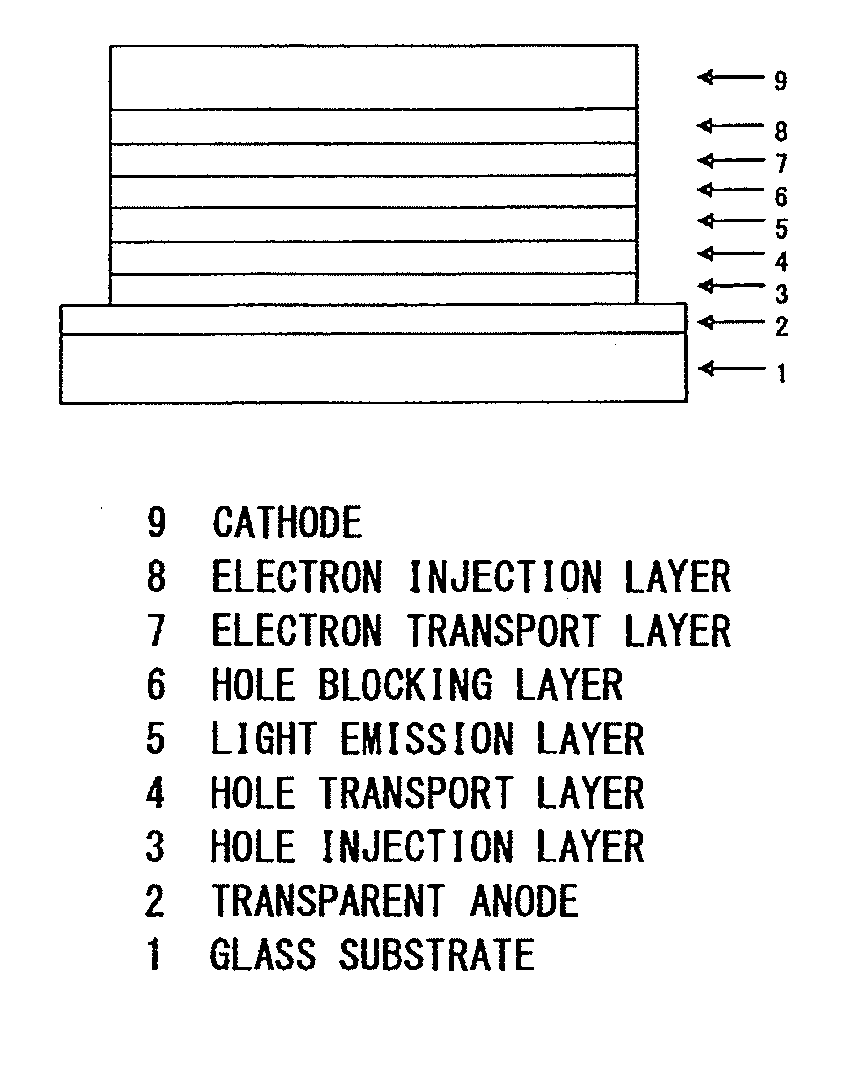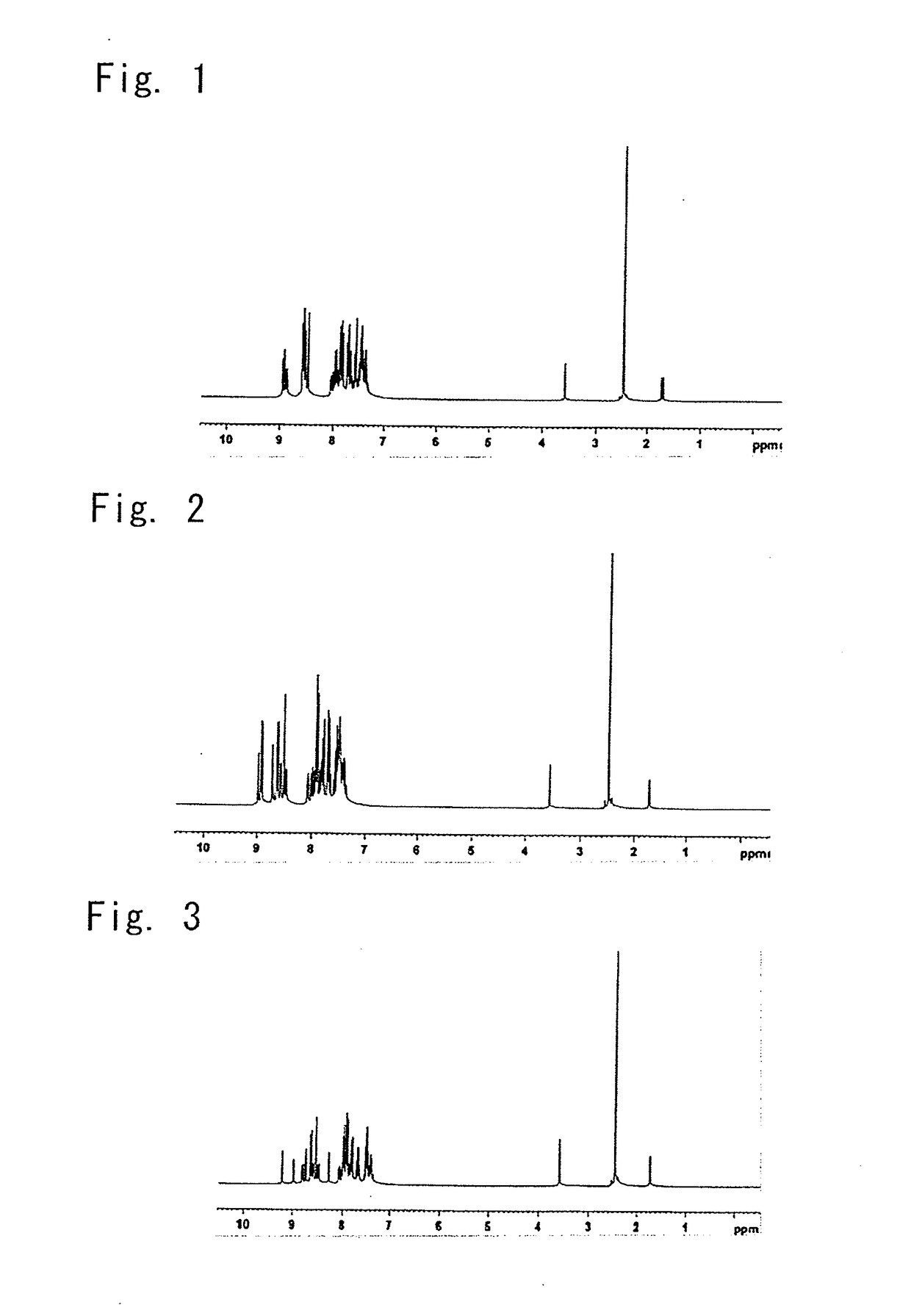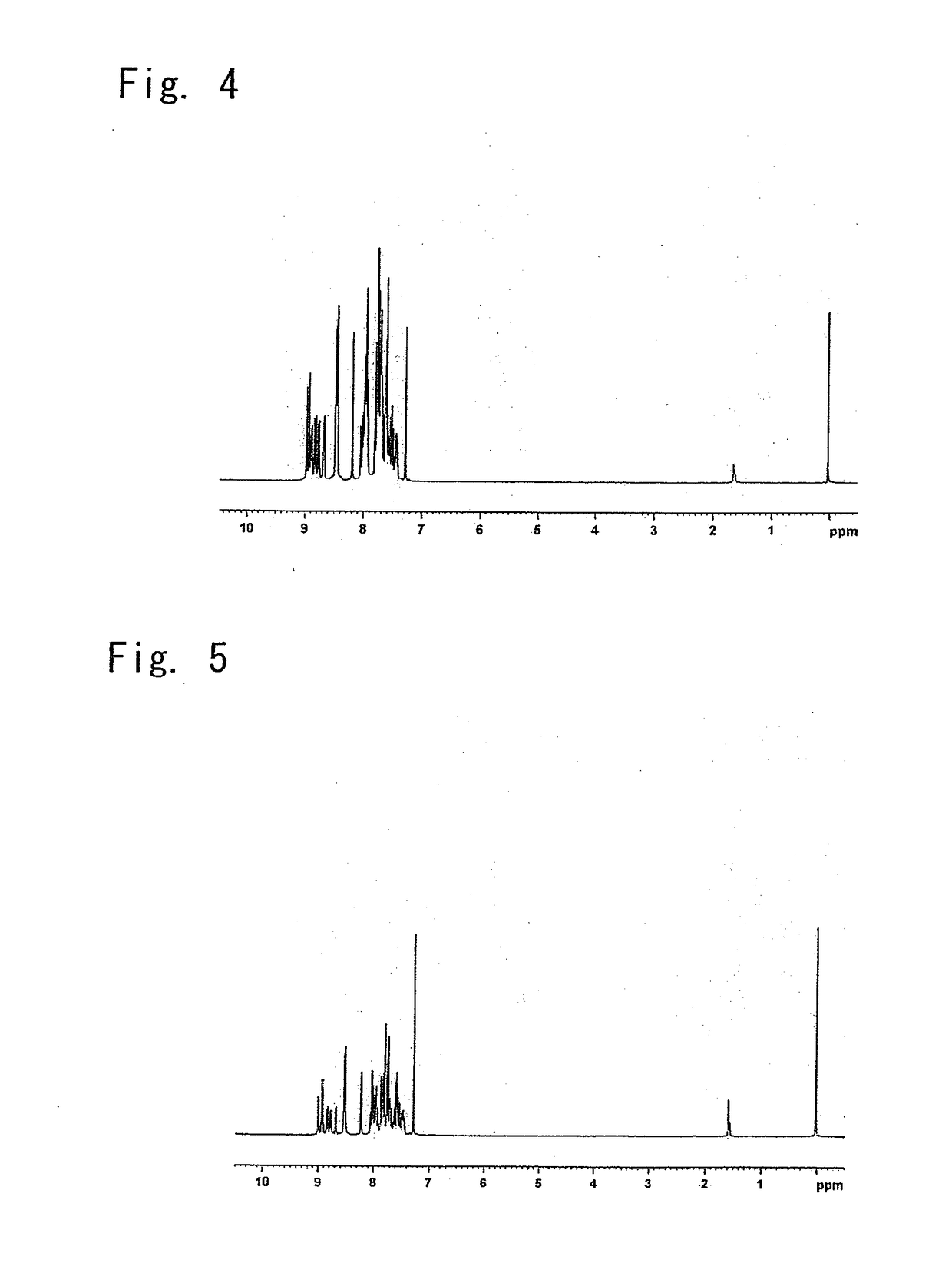Pyrimidine derivative and an organic electroluminescent device
a technology of organic electroluminescent devices and pyrimidine, which is applied in the direction of luminescent compositions, organic chemistry, chemistry apparatus and processes, etc., can solve the problems of low heat resistance, material deterioration, and confinement of excitons generated within the luminous layer, and achieve excellent heat resistance, high electron injection and moving rate, and electron transport efficiency. effect of electron transpor
- Summary
- Abstract
- Description
- Claims
- Application Information
AI Technical Summary
Benefits of technology
Problems solved by technology
Method used
Image
Examples
example 1
of Compound 74
Synthesis of 4-(biphenyl-4-yl)-2-{3-(naphthalen-1-yl)phenyl}-6-{4-(pyridin-3-yl)phenyl}pyrimidine
[0267]
A nitrogen-purged reaction vessel was charged with5.0g,3-(naphthalen-1-yl)phenylboronic acid2-chloro-4-(biphenyl-4-yl)-6-{4-(pyridin-3-yl)phenyl}7.0g,pyrimidinetetrakistriphenylphosphine0.96g,potassium carbonate6.9g,toluene35ml,1,4-dioxane70ml andwater35ml.
The mixture was heated, and stirred for 12 hours at 85° C. The mixture was cooled to room temperature, and then an organic layer was collected by liquid separation. Then, the organic layer was concentrated under reduced pressure to obtain a crude product. The crude product was purified by column chromatography (carrier: silica gel, eluent: heptane / dichloromethane / THF), and then subjected to purification by recrystallization using a chlorobenzene / dichloromethane mixed solvent to obtain 3.1 g (yield 32%) of
[0268]4-(biphenyl-4-yl)-2-(3-(naphthalen-1-yl)phenyl)-6-{4-(pyridin-3-yl)phenyl}pyrimidine (Compound 74) as a whi...
example 2
of Compound 84
4-(biphenyl-3-yl)-2-{4-(naphthalen-1-yl)phenyl}-6-{4-(pyridin-3-yl)phenyl}pyrimidine
[0273]
[0274]In Example 1,[0275]4-(naphthalen-1-yl)phenylboronic acid was used instead of[0276]3-(naphthalen-1-yl)phenylboronic acid, and[0277]2-chloro-4-(biphenyl-3-yl)-6-{4-(pyridin-3-yl)phenyl}pyrimidine was used instead of[0278]2-chloro-4-(biphenyl-4-yl)-6-{4-(pyridin-3-yl)phenyl}pyrimidine,
and the reaction was performed under the same conditions. As a result, 3.8 g (yield 39%) of 4-(biphenyl-3-yl)-2-{4-(naphthalen-1-yl)phenyl}-6-{4-(pyridin-3-yl)phenyl}pyrimidine (Compound 84) was obtained as a white powder.
[0279]In connection with the resulting white powder, its structure was identified using NMR. The results of its 1H-NMR measurement are shown in FIG. 2. In 1H-NMR (THF-d8), the following signals of 29 hydrogens were detected.[0280]δ (ppm)=8.99 (1H)[0281]8.93 (2H)[0282]8.72 (1H)[0283]8.65 (2H)[0284]8.59 (1H)[0285]8.52 (1H)[0286]8.49 (1H)[0287]8.09 (1H)[0288]8.04-7.34 (19H)
example 3
of Compound 89
4-(biphenyl-3-yl)-2-{3-(naphthalen-2-yl)phenyl}-6-{4-(pyridin-3-yl)phenyl}pyrimidine
[0289]
[0290]In Example 1,[0291]3-(naphthalen-2-yl)phenylboronic acid was used instead of[0292]3-(naphthalen-1-yl)phenylboronic acid, and[0293]2-chloro-4-(biphenyl-3-yl)-6-{4-(pyridin-3-yl)phenyl}pyrimidine was used instead of[0294]2-chloro-4-(biphenyl-4-yl)-6-{4-(pyridin-3-yl)phenyl}pyrimidine,
and the reaction was performed under the same conditions. As a result, 5.8 g (yield 59%) of 4-(biphenyl-3-yl)-2-{3-(naphthalen-2-yl)phenyl}-6-{4-(pyridin-3-yl)phenyl}pyrimidine (Compound 89) was obtained as a yellow powder.
[0295]In connection with the resulting yellow powder, its structure was identified using NMR. The results of its 1H-NMR measurement are shown in FIG. 3. In 1H-NMR (THF-d8), the following signals of 29 hydrogens were detected.[0296]δ (ppm)=9.21 (1H)[0297]8.98 (1H)[0298]8.80 (1H)[0299]8.74 (1H)[0300]8.64 (2H)[0301]8.59 (1H)[0302]8.53 (1H)[0303]8.46 (1H)[0304]8.29 (1H)[0305]8.08 (1...
PUM
| Property | Measurement | Unit |
|---|---|---|
| luminance | aaaaa | aaaaa |
| quantum efficiency | aaaaa | aaaaa |
| work function | aaaaa | aaaaa |
Abstract
Description
Claims
Application Information
 Login to View More
Login to View More - R&D
- Intellectual Property
- Life Sciences
- Materials
- Tech Scout
- Unparalleled Data Quality
- Higher Quality Content
- 60% Fewer Hallucinations
Browse by: Latest US Patents, China's latest patents, Technical Efficacy Thesaurus, Application Domain, Technology Topic, Popular Technical Reports.
© 2025 PatSnap. All rights reserved.Legal|Privacy policy|Modern Slavery Act Transparency Statement|Sitemap|About US| Contact US: help@patsnap.com



